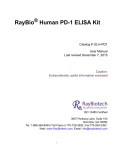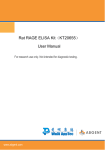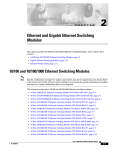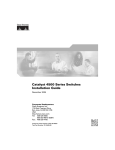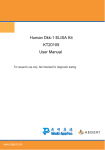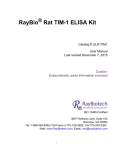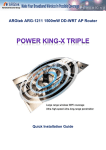Download Human WISP-1 ELISA Kit(KT20408) User Manual
Transcript
Human WISP-1 ELISA Kit(KT20408) User Manual For research use only. Not intended for diagnostic testing. www.abgent.com TABLE OF CONTENTS I. Introduction……..……………………………….2 II. Reagents……………………………..…………..2 III. Storage.…………………………………….…… . 3 IV. Additional Materials Required………………….. 3 V. Reagent Preparation……………………………… 3 VI. Assay Procedure……………………………........ 5 VII. Assay Procedure Summary…………………….... 7 VIII. Calculation of Results A. Typical Data…..……………………….…….….8 B. Sensitivity……………………………….….……8 C. Recovery…………………………..……………..8 D. Linearity………………………………….…........ 9 E. Reproducibility…………………………………... 9 IX. Specificity………………………………………. .9 X. Troubleshooting Guide.……………………....….10 1 I. INTRODUCTION The Human WISP-1 (Wnt-induced secreted protein 1; also CNN4) ELISA (Enzyme-Linked Immunosorbent Assay) kit is an in vitro enzymelinked immunosorbent assay for the quantitative measurement of human WISP-1 in serum, plasma (collect plasma using EDTA as an anticoagulant. Heparin and Citrate are not recommended as anticoagulants for use in this assay), cell culture supernatants and urine. This assay employs an antibody specific for human WISP-1 coated on a 96-well plate. Standards and samples are pipetted into the wells and WISP-1 present in a sample is bound to the wells by the immobilized antibody. The wells are washed and biotinylated anti-human WISP-1 antibody is added. After washing away unbound biotinylated antibody, HRP-conjugated streptavidin is pipetted to the wells. The wells are again washed, a TMB substrate solution is added to the wells and color develops in proportion to the amount of WISP-1 bound. The Stop Solution changes the color from blue to yellow, and the intensity of the color is measured at 450 nm. II. REAGENTS 1. WISP-1 Microplate (Item A): 96 wells (12 strips x 8 wells) coated with anti-human WISP-1. 2. Wash Buffer Concentrate (20x) (Item B): 25 ml of 20x concentrated solution. 3. Standards (Item C): 2 vials of recombinant human WISP-1. 4. Assay Diluent C (Item L): 30 ml diluent buffer. For Standard/Sample (serum/plasma) diluent. 5. Assay Diluent B (Item E): 15 ml of 5x concentrated buffer. For Standard/Sample (cell culture medium/urine) diluent. 6. Detection Antibody (Item F): 2 vial of biotinylated anti-human WISP-1 (each vial is enough to assay half microplate). 7. HRP-Streptavidin Concentrate (Item G): 200 µl 300x concentrated HRP-conjugated streptavidin. 2 8. TMB One-Step Substrate Reagent (Item H): 12 ml of 3,3’,5,5’tetramethylbenzidine (TMB) in buffer solution. 9. Stop Solution (Item I): 8 ml of 0.2 M sulfuric acid. III. STORAGE May be stored for up to 6 months at 2o to 8oC from the date of shipment. Standard (recombinant protein) should be stored at -20 oC or -80 oC (recommended at –80 oC) after reconstitution. Opened Microplate Wells or reagents may be stored for up to 1 month at 2o to 8oC. Return unused wells to the pouch containing desiccant pack, reseal along entire edge. Note: the kit can be used within one year if the whole kit is stored at -20 oC. Avoid repeated freeze-thaw cycles. IV. ADDITIONAL MATERIALS REQUIRED 1 2 3 4 5 6 7 8 Microplate reader capable of measuring absorbance at 450 nm. Precision pipettes to deliver 2 µl to 1 ml volumes. Adjustable 1-25 ml pipettes for reagent preparation. 100 ml and 1 liter graduated cylinders. Absorbent paper. Distilled or deionized water. Log-log graph paper or computer and software for ELISA data analysis. Tubes to prepare standard or sample dilutions. V. REAGENT PREPARATION 1. Bring all reagents and samples to room temperature (18 - 25°C) before use. 2. Sample dilution: If your samples need to be diluted, Assay Diluent A (Item D) should be used for dilution of serum/plasma samples. 1x Assay 3 Diluent B (Item E) should be used for dilution of culture supernatants and urine. Suggested dilution for normal serum/plasma: 2 fold*. * Please note that levels of the target protein may vary between different specimens. Optimal dilution factors for each sample must be determined by the investigator. 3. Assay Diluent B should be diluted 5-fold with deionized or distilled water before use. 4. Preparation of standard: Briefly spin the vial of Item C and then add 400 µl Assay Diluent C (for serum/plasma samples) or 1x Assay Diluent B (for cell culture supernates/urine) into Item C vial to prepare a 100 ng/ml standard. Dissolve the powder thoroughly by a gentle mix. Add 75 µl WISP-1 standard (100 ng/ml) from the vial of Item C, into a tube with 425 µl Assay Diluent C or 1x Assay Diluent B to prepare a 15,000 pg/ml standard solution. Pipette 300 µl Assay Diluent C or 1x Assay Diluent B into each tube. Use the 15,000 pg/ml standard solution to produce a dilution series (shown below). Mix each tube thoroughly before the next transfer. Assay Diluent C or 1x Assay Diluent B serves as the zero standard (0 pg/ml). The 15,000 pg/ml standard point may be saturated in Assay Diluent B, we recommend starting from 6,000 pg/ml. 75 µl standard + 425 µl 15,000 pg/ml 200µl 200 µl 6,000 pg/ml 2,400 pg/ml 200 µl 200 µl 960 pg/ml 384 pg/ml 200 µl 153.6 pg/ml 200 µl 61.44 pg/ml 0 pg/ml 5. If the Wash Concentrate (20x) (Item B) contains visible crystals, warm to room temperature and mix gently until dissolved. Dilute 20 ml of 4 Wash Buffer Concentrate into deionized or distilled water to yield 400 ml of 1x Wash Buffer. 6. Briefly spin the Detection Antibody vial (Item F) before use. Add 100 µl of 1x Assay Diluent B into the vial to prepare a detection antibody concentrate. Pipette up and down to mix gently (the concentrate can be stored at 4°C for 5 days). The detection antibody concentrate should be diluted 80-fold with 1x Assay Diluent B and used in step 4 of Part VI Assay Procedure. 7. Briefly spin the HRP-Streptavidin concentrate vial (Item G) and pipette up and down to mix gently before use. HRP-Streptavidin concentrate should be diluted 300-fold with 1x Assay Diluent B. For example: Briefly spin the vial (Item G) and pipette up and down to mix gently . Add 40 µl of HRP-Streptavidin concentrate into a tube with 12 ml 1x Assay Diluent B to prepare a 300-fold diluted HRPStreptavidin solution (don’t store the diluted solution for next day use). Mix well. VI. ASSAY PROCEDURE: 1. Bring all reagents and samples to room temperature (18 - 25°C) before use. It is recommended that all standards and samples be run at least in duplicate. 2. Add 100 µl of each standard (see Reagent Preparation step 2) and sample into appropriate wells. Cover well and incubate for 2.5 hours at room temperature or over night at 4°C with gentle shaking. 3. Discard the solution and wash 4 times with 1x Wash Solution. Wash by filling each well with Wash Buffer (300 µl) using a multi-channel Pipette or autowasher. Complete removal of liquid at each step is 5 essential to good performance. After the last wash, remove any remaining Wash Buffer by aspirating or decanting. Invert the plate and blot it against clean paper towels. 4. Add 100 µl of 1x prepared biotinylated antibody (Reagent Preparation step 6) to each well. Incubate for 1 hour at room temperature with gentle shaking. 5. Discard the solution. Repeat the wash as in step 3. 6. Add 100 µl of prepared Streptavidin solution (see Reagent Preparation step 7) to each well. Incubate for 45 minutes at room temperature with gentle shaking. 7. Discard the solution. Repeat the wash as in step 3. 8. Add 100 µl of TMB One-Step Substrate Reagent (Item H) to each well. Incubate for 30 minutes at room temperature in the dark with gentle shaking. 9. Add 50 µl of Stop Solution (Item I) to each well. Read at 450 nm immediately. 6 VII. ASSAY PROCEDURE SUMMARY 1. Prepare all reagents, samples and standards as instructed. 2. Add 100 µl standard or sample to each well. Incubate 2.5 hours at room temperature or over night at 4oC. 3. Add 100 µl prepared biotin antibody to each well. Incubate 1 hour at room temperature. 4. Add 100 µl prepared Streptavidin solution. Incubate 45 minutes at room temperature. 5. Add 100 µl TMB One-Step Substrate Reagent to each well. Incubate 30 minutes at room temperature. 6. Add 50 µl Stop Solution to each well. Read at 450 nm immediately. VIII. CALCULATION OF RESULTS Calculate the mean absorbance for each set of duplicate standards, controls and samples, and subtract the average zero standard optical density. Plot the standard curve on log-log graph paper or using Sigma plot software, with standard concentration on the x-axis and absorbance on the y-axis. Draw the best-fit straight line through the standard points. 7 A. TYPICAL DATA These standard curves are for demonstration only. A standard curve must be run with each assay. Assay Diluent B Assay Diluent C 10 OD=450 nm OD=450 nm 10 1 0.1 0.01 10 100 1,000 10,000 1 0.1 0.01 10 100,000 100 1,000 10,000 Human WISP-1 concentration (pg/ml) Human WISP-1 concentration (pg/ml) B. SENSITIVITY The minimum detectable dose of WISP-1 is typically less than 50 pg/ml. C. RECOVERY Recovery was determined by spiking various levels of human WISP-1 into human serum, EDTA plasma and cell culture media. Mean recoveries are as follows: 8 Sample Type Average % Recovery Range (%) Serum 90.42 80-97 Plasma 127.1 119-135 Cell culture media 93.12 87-101 D. LINEARITY Sample Type Serum Plasma Cell Culture Media 1:2 Average % of Expected Range (%) 85.60 80-97 108.6 100-115 109.6 102-116 1:4 Average % of Expected Range (%) 75.51 67-83 92.01 84-100 117.7 109-125 E. REPRODUCIBILITY Intra-Assay: CV<10% Inter-Assay: CV<12% IX. SPECIFICITY Cross Reactivity: In this sandwich ELISA format, no cross-reactivity was observed with rhBiglycan, rhDecorin, rhNOV, or rhWISP-3. 9 X. TROUBLESHOOTING GUIDE Problem 1. Poor standard curve 2. Low signal 3. Large CV 4. High background 5. Low sensitivity Cause 1. Inaccurate pipetting Solution 1. Check pipettes 2. Improper standard dilution 2. Ensure a brief spin of Item C and dissolve the powder thoroughly by a gentle mix. 1. Ensure sufficient incubation time; assay procedure step 2 may change to over night 2. Check pipettes and ensure correct preparation 1. Check pipettes 1. Review the manual for proper wash. If using a plate washer, check that all ports are unobstructed. 2. Make fresh wash buffer 1. Store your standard at<-20oC after reconstitution, others at 4 oC. Keep substrate solution protected from light 2. Stop solution should be added to each well before measure 1.Too brief incubation times 2. Inadequate reagent volumes or improper dilution 1. Inaccurate pipetting 1. Plate is insufficiently washed 2. Contaminated wash buffer 1. Improper storage of the ELISA kit 2. Stop solution 10 Note: This product is for research use only. 11 USA Abgent,Inc. Toll Free (888)735-7227 Or (858)875-1900 [email protected] CHINA Abgent Suzhou +86 512 69369088 [email protected] EUROPE Abgent Europe +44(0) 1235 854042 [email protected] For other countries www.abgent.com













